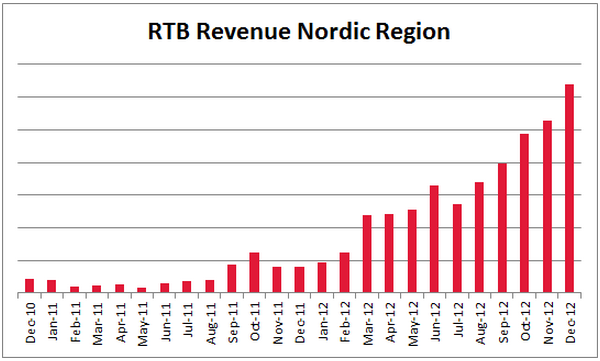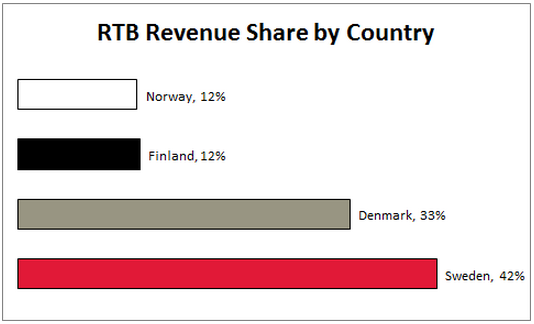Nordic RTB-Adoption On The Rise: Industry Reaction
by Romany Reagan on 15th Mar 2013 in News

The Rubicon Project recently released some localised data in its Nordic RTB Market Growth blog post. At ATS Stockholm last May, ExchangeWire saw a fairly nascent market still testing and probing the potential of impression-level buying. Rubicon's report on the Nordics seems to indicate a big adoption of RTB-based buying (see graphs below).
We caught up with some of last year’s ATS Stockholm speakers and local ad exec leaders to get their ‘on-the-ground’ perspective of developments in the data-driven market, and whether or not RTB is having an impact on the wider digital ad market in the region.
Johan Pettersson, Digital Director, Starcom Sweden:
“It is great to see the developments of the last six to nine months, where particularly Denmark and Sweden have taken big steps. To simplify this slightly, it has been driven from the buy side, supported by international publishers and the effort from SSPs like Netrics Sales/Rubicon Project. With the exception of Danish publishers, the bigger local publishers have been using this time to build technology and make trials in a smaller scale. But we have also set up our first private marketplaces, so my prediction is that we will see much more local inventory made available the coming months as our markets continue to mature, which will drive the market even further.”
Otto Neubert, Managing Director, Emediate:
“I think the Nordic Rubicon report reflects exactly our experience during the last couple of months. The growing interest in programmatic buying is being fueled by increased demand and the obvious advantages it brings to advertisers and publishers. Last week, a panel of RTB specialists at Danske Mediers RTB conference in Copenhagen predicted that 20% of all online media would be bought via RTB by the end of 2013. I estimate that we can reach that level far before then if our publishers keep signing up to our SSP with same speed as we see now. RTB is sizzling hot!”
Jukka Sundquist, Head of Performance, KLiKKi:
“Since ATS Stockholm, things started with a great hype but there wasn't really a good understanding about what RTB buying was about at that point. It was more of a general interest about a new possibility in digital marketing. That lasted for some months, but because some of the advertisers went to the RTB world for the wrong reasons, or no reasons at all, they were in some cases disappointed. The basic question of ‘why’ this channel should be used was forgotten.
About the same time there started to be problems with the quality of sites available through the exchanges. Some suspicious sites were able to get tags from exchanges or networks connected to the exchanges, and thus nordic advertisers started to get visibility from places they didn't want. Hence a dialog with the exchanges about the matter started and precautions were made in different DSPs all over Nordics (to my understanding at least). Advertisers started to demand for more local and trusted inventory.
Also, at latter part of 2012, local networks and media houses started to show interest in putting their inventory to DSPs. This process has been slow, but just now we are seeing, for example, in Finland, the first local players being present in DSPs.”
Dilem Guler,CEO, Netric Sales
The Nordic market is rapidly adapting to automated trading. Nordic YoY growth 2011-2012 of ad views passed via RTB amounted to some 550% for the region. Nordic media agencies felt that they were the last ones to get onboard the search train, when that happened a few years back. Seeing big opportunities in automated trading, and of course glancing at their colleagues in Europe and the US, they do not want to make that mistake again. Local DSPs like Adform and Delta Projects are working alongside agencies with better traction, helping with trading and technology and moving the market forward even faster. The message has also reached advertisers who are embracing the opportunity of high-relevance and better targeted contacts.
At the same time, we see that large publishers are building stronger strategies around their unsold and premium inventory. Many of them, who have lost faith in ad networks, see the transparency and control offered by sell-side technologies as appealing for them to create new opportunities, without losing money on premium deals, while also opening up to new types of demand sources. Altogether, they are seeing a higher yield on their non-guaranteed inventory and the RTB contribution is becoming a sizable part of their total revenue stream. Smaller publishers can see the opportunity in getting a larger chunk of the branding budgets that otherwise would be out of reach, and at the same time getting a more efficient sales department.
Private Marketplaces are emerging and are considered a powerful tool to strengthen the relationship with the top tier clients, rightfully considered as part of the premium offer from the publisher.
Simone Skoog, Managing Director, Criteo, Nordics:
The last 12 months have seen a rise in the significance of RTB, within the overall industry and even more for Criteo specifically.
Publishers are increasingly realising the value of RTB platforms in order to sell their inventory and this is truer than ever before in the Nordic’s, where Criteo already works with hundreds of clients. It’s the automated and real time nature of RTB that enables us to serve billions of ads every day – about 520,000 different product images every 10 seconds. In order to remain a market leader and ensure our competitive advantage, we constantly source our inventory through a combination of direct publisher relationships and through exchange platforms.
The real challenge for RTB in the future is transparency, we can already see that yield is driving up CPM and it will be interesting to see how this evolves. Criteo is already using its tried and tested technology at different stages of the marketing funnel – to not only engage with consumers who have expressed interest by visiting a website - but to also help brands find potentially new consumers all together. Similarly, as RTB becomes more than just a niche technology utilised by a few, it will be interesting to see whether advertisers will find a way to spend their brand budgets through these platforms.
Josh Mortensen, CEO, GlibHippo:
"RTB and programmatic buying in the Nordics is like – queue hackneyed analogy – teenage sex. There is a lot of talk and not much action.
"Despite the presence of Xaxis, Vivaki, Accuen, and graphs showing triple digit (percentage) growth, the Nordics are still in the toddler years. The trading desk remains largely unknown outside one or two executive offices. There are some nascent projects, but words like RTB, programmatic, data and audience are not trending in Nordic digital departments.
"There is a lot of exchange buying because it is cheap, but data-driven audience buying is a long way off. Asking advertisers and media agencies to unlearn the last 100 years of advertising is a difficult sell. Convincing advertisers that audiences can be targeted independent of content – that a blackbox makes the model they know irrelevant – is an epic conceptual shift. It cannot be understated. While clients and agencies are still asking to see site lists, fixating on the word ‘premium’, asking for screenshots and using CTR as a KPI, the ambiguity of ‘audience’ buying, is going to be a difficult sell.
"Interestingly, the publishers seem to have taken the initiative, particularly in Denmark (see: DPN and the aforementioned cheap exchange traffic). This development is likely to have a serious impact on the bigger agencies and advertisers, reducing their ability to negotiate substantial discounts (the video CPM floor rumors I hear tend to confirm this)."
The report suggests a shift in some buying patterns across the market, but we are still in the early days. As ExchangeWire learned last year at its first ATS Stockholm event, the sell-side, which is effectively controlled by a handful of powerful regional publishers, still needs to be convinced of the true value of impression-level buying. In saying that, the recent move by a number of top Danish publishers indicates that some of the region's big players are prepared to trade substantial amounts of inventory through RTB. It will be interesting to see if that growth continues, when the Agency Trading Desks really get traction in the market, and whether or not the future model will be a hybrid of RTB and programmatic guaranteed.
DataDisplayDSPExchangeNordicsProgrammaticSSPTargetingTrading Desk










Follow ExchangeWire